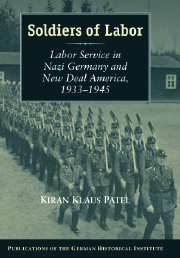Book contents
- Frontmatter
- Introduction
- 1 A Panacea for the Great Depression? Labor Service Ideas and Their Implementation Prior to 1933
- 2 Service to the Community: The Organization of the Labor Services
- 3 “Citizens,” Volksgenossen, and Soldiers: Education in the Labor Services
- 4 In “The Grandeurs of Nature”: The Work of the Labor Services
- Concluding Reflections
- Abbreviations
- Sources and Bibliography
- Index
Introduction
Published online by Cambridge University Press: 05 January 2013
- Frontmatter
- Introduction
- 1 A Panacea for the Great Depression? Labor Service Ideas and Their Implementation Prior to 1933
- 2 Service to the Community: The Organization of the Labor Services
- 3 “Citizens,” Volksgenossen, and Soldiers: Education in the Labor Services
- 4 In “The Grandeurs of Nature”: The Work of the Labor Services
- Concluding Reflections
- Abbreviations
- Sources and Bibliography
- Index
Summary
When important visitors from the world of politics, business, or culture came to Nazi Germany in the years before World War II, one stop was almost always on their itinerary: a camp of the Labor Service (Arbeitsdienst). The Fascist dictator Benito Mussolini, the Indian civil rights activist Jawaharlal Nehru, the pro-Nazi Swedish explorer Sven Hedin, a delegation of influential French businessmen, and the regent of Afghanistan - these visitors shared little beyond their interest in this institution of the Nazi state. Touring a camp was not one of the obligatory events that state guests and dignitaries were often compelled to endure, yet many visitors expressed a personal desire to see one of the remote Labor Service sites. In the end, quite a few returned with a positive impression of this Nazi institution. The Labor Service, little studied and largely ignored after 1945, evidently exerted a fascination on international observers that should not be underestimated.
The Nazi regime placed high hopes in its Labor Service. It was to be an instrument for overcoming mass unemployment, the country's dependence on agricultural imports, and the physical and spiritual crisis of Germany's youth. Moreover, it was charged with creating a new work ethic, providing paramilitary training, and aiding in the construction of a new national culture (Volkskultur). Last, but not least, it was regarded as “the best means of making this National Socialist call for a Volksgemeinschaft [national community] a reality.”
- Type
- Chapter
- Information
- Soldiers of LaborLabor Service in Nazi Germany and New Deal America, 1933–1945, pp. 1 - 21Publisher: Cambridge University PressPrint publication year: 2005

